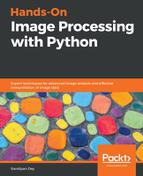Histogram matching is a process where an image is altered in such a way that its histogram matches that of another reference (template) image's histogram. The algorithm is as follows:
- The cumulative histogram is computed for each image, as shown in the following screenshot.
- For any given pixel value, xi, in the input image (to be adjusted), we need to find the corresponding pixel value, xj, in the output image by matching the input image's histogram with the template image's histogram.
- The xi pixel value has a cumulative histogram value given by G(xi). Find a pixel value, xj,so that the cumulative distribution value in the reference image, namely H(xj), is equal to G(xi).
- The input data value xi is replaced by xj:

The following code block shows how histogram matching can be implemented using Python:
def cdf(im):
'''
computes the CDF of an image im as 2D numpy ndarray
'''
c, b = cumulative_distribution(im)
# pad the beginning and ending pixels and their CDF values
c = np.insert(c, 0, [0]*b[0])
c = np.append(c, [1]*(255-b[-1]))
return c
def hist_matching(c, c_t, im):
'''
c: CDF of input image computed with the function cdf()
c_t: CDF of template image computed with the function cdf()
im: input image as 2D numpy ndarray
returns the modified pixel values for the input image
'''
pixels = np.arange(256)
# find closest pixel-matches corresponding to the CDF of the input image, given the value of the CDF H of
# the template image at the corresponding pixels, s.t. c_t = H(pixels) <=> pixels = H-1(c_t)
new_pixels = np.interp(c, c_t, pixels)
im = (np.reshape(new_pixels[im.ravel()], im.shape)).astype(np.uint8)
return im
pylab.gray()
im = (rgb2gray(imread('../images/beans_g.png'))*255).astype(np.uint8)
im_t = (rgb2gray(imread('../images/lena_g.png'))*255).astype(np.uint8)
pylab.figure(figsize=(20,12))
pylab.subplot(2,3,1), plot_image(im, 'Input image')
pylab.subplot(2,3,2), plot_image(im_t, 'Template image')
c = cdf(im)
c_t = cdf(im_t)
pylab.subplot(2,3,3)
p = np.arange(256)
pylab.plot(p, c, 'r.-', label='input')
pylab.plot(p, c_t, 'b.-', label='template')
pylab.legend(prop={'size': 15})
pylab.title('CDF', size=20)
im = hist_matching(c, c_t, im)
pylab.subplot(2,3,4), plot_image(im, 'Output image with Hist. Matching')
c1 = cdf(im)
pylab.subplot(2,3,5)
pylab.plot(np.arange(256), c, 'r.-', label='input')
pylab.plot(np.arange(256), c_t, 'b.-', label='template')
pylab.plot(np.arange(256), c1, 'g.-', label='output')
pylab.legend(prop={'size': 15})
pylab.title('CDF', size=20)
pylab.show()
The following screenshot shows the output of the previous code. As can be seen, the output bean image's CDF coincides with the input Lena image's CDF after histogram matching, and this enhances the contrast of the low-contrast input bean image:

